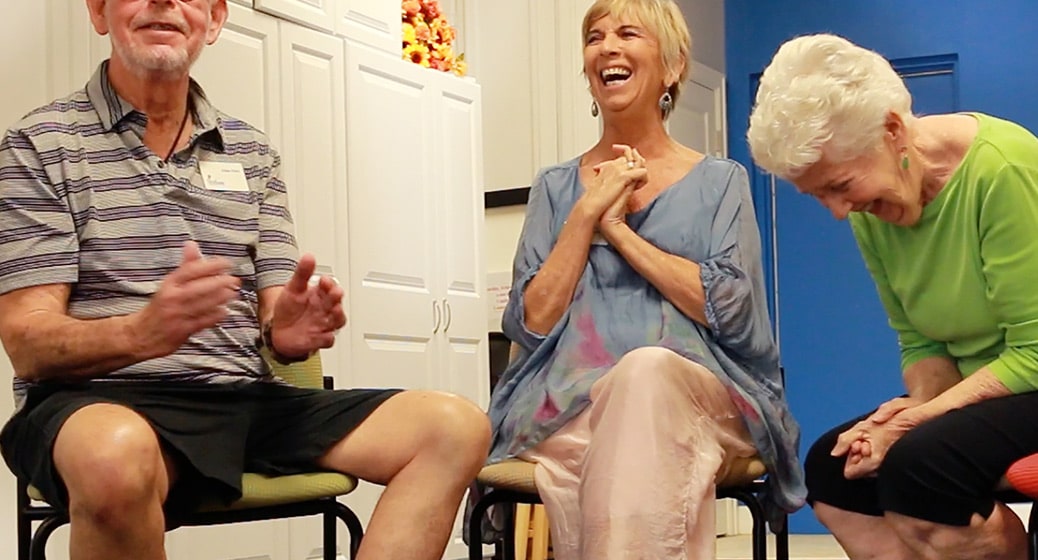Applied improv is a wonderful tool to help people living with behavioral issues such as anxiety and coping with chronic issues like pain and anxiety. Discovering improv has not only benefited my life but those of my patients.
Carla is a 63-year-old woman retired nurse and owned a Home Infusion Center for 24 years. She has been happily married for 30 years.
She has been seen in my practice since February 2022.
Carla suffered a fall in 2018 that led to a spinal fusion and chronic pain and also described a long history of depression. She thinks that the morphine she is on is contributing to her depression.
She is on multiple pain medications including morphine and said that despite these meds she was in pain daily.
My training has included pain management with hypnosis, and mindfulness training, and I’ve found that using improvisational theatre games is very useful. When the patient is focused, they often become unaware of their pain, and the production of endorphins and dopamine increase feelings of well-being.
Because of her sense of humor, self-confidence, and intelligence, I decided to introduce mindfulness, meditation, and improv games quickly into her treatment. However, not all of my patients have such high self-confidence. Many of my clients struggle with social anxiety and it often takes several sessions for them to develop a trusting, therapeutic relationship with their therapist before we can try some of these experiential techniques. But they can also be helped with Improvisational Games.
At our first session, I introduced the concept of mindfulness and meditation. We explored the concept of being in the present. When she started to experience anxiety, I asked her to say to herself “be here now.” I used a technique called “body scan,” where I led her to relax each part of her body, from the top of her head to her feet. I also used a Viola Spolin exercise called “Feeling Self with Self “and a two-minute silent meditation. We worked on her breathing and the idea that her thoughts of anxiety and fear would dissipate through focused breathing as we increased the time of each silent meditation.
In session two I introduced the improv concept of “Yes, and.” This is a concept that means whatever your improv partner says to you excepted, that’s the yes, and then you add to it and that is the end. For example, my partner might say to me I heard that you went to Mars last week. And I could respond “yes, and I’ll be spending Thanksgiving and Christmas with them!”! So, I’ve agreed or said yes to the statement my partner made, and then I use the and by giving more detail. This is how we play and often turns into a scene. We also played Story Spine.
We also taught the Gibberish exercise and games. Gibberish is a Spolin exercise that she developed while working with Neva Boyd at Hull House. Their students were immigrant children from all over Europe. Gibberish is exactly what it sounds like! The player speaks in a non-sensical language made up of vowels and consonants. Gibberish allowed the children to be able to communicate with each other.
Like most newcomers to improv, she was concerned about “doing it wrong,” but was able to overcome that with the improv concept that “nothing is wrong or a mistake when we improvise.” This idea that there are no failures in improv and that you can’t get things wrong definitely decreases the anxiety or performance stress when they understand that no matter what they do it’s going to be a gift to their partner, me as a therapist, or the other students if they’re in group therapy. Quite often I teach the “Ta Da “
This is a movement combined with the words ta-da. They throw their hands up in the air and in a loud voice say Ta Da! I frequently observed that when one person says the Ta Dah it is like a group response and soon everyone is using that little phrase and laughing at themselves.
https://www.rehearsalsforgrowth.com
These interventions produced laughter and smiles from Carla. Laughter increases Dopamine levels, which decreases feelings of sadness.
We began meeting bi-weekly as she had many doctor appointments and physical therapy at a therapeutic indoor pool with licensed physical trainers. In our fourth session, we played the game “Tiger, Martian. Cow.” In this exercise, the player is required to change their facial expression, use specific body movements, and make a sound as either a tiger, a Martian, or a cow. When making these faces and sounds like a tiger, my patience “get out of their head” and just relax into the game. It’s very hard to have stressful thoughts when you’re involved in such a game. Carla and other of my patients find that this exercise takes them away from those anxiety-provoking thoughts and leads them into the relaxation response.
We increased the time of the meditation to seven minutes, with the suggestion that she practice this daily (the caveat being that if she didn’t practice, she wouldn’t be graded or judged).
In the following session, we played the Fortunately/Unfortunately a storytelling game that requires focus and active listening. Then I introduced a two-person scene game with a Who, What, and Where. This means Who is the character in the scene, what unusual object is named and where is the location. Carla threw herself into this experience. She described how much better she felt at the end of this session.
Over the next few sessions, we played Spolin’s exercise “Mirror/ Mirror Follow the Follower” at the beginning of each meeting. Carla found this game particularly calming.
Carla was seeing multiple pain specialists about injections to decrease pain and possible surgery. She was disappointed that her injections weren’t really helping with the pain. And, there was no evidence that the suggested surgery would be successful, which led to the “What If” game. This is used in CBT to help a patient go to the very worst scenario when they have fear about an event that may or may not happen. This reinforces the use of meditation which Carla is currently practicing for ten minutes, usually twice a day.
In our fifth month of treatment, I asked Carla if she was feeling any benefit from the improv. She responded “It makes me laugh! I feel less anxious and forget the pain.”
We are now introducing her husband to the art of improv and encouraging them both to play daily. There are many researchers investigating and measuring the impact that improvisational theatre games have in psychotherapy with individuals, couples, and families. If you’ve never tried improvisational theatre games, I strongly suggest you do!
THE STORY SPINE by Kenn Adams
This is a form of telling a story where one uses flashcards for each part of the story. The flash card has the beginning line for the first player, then a different one for each subsequent player. The point of this tool is to provide a model for a well-constructed story with a beginning that establishes a routine, an event that breaks the routine, a middle that shows the consequence of having broken the routine, a climax that sets the resolution to the story in motion, and the resolution. It goes like this:
- Once upon a time…
- Every day…
- But, one day…
- Because of that…
- Because of that…
- Because of that…
- Until finally…
- And, ever since then…
- These or just a few of the many improvisational theater games that I use in my practice. There is growing research among psychologists and doctors on the psychological and physical benefits of improv and those are included in this bibliography below.
If you are a clinician and have ever thought about using this incredible technique there are many sources you can go to, especially “rehearsals for growth!” Which you can find at www.rehearsalforgrowth.com. Dr. Daniel Wiener, a psychologist who studied improv with Keith Johnstone, wrote this groundbreaking book in 1994.
In this book he illuminates the connection between theater and therapy, shows how performing improvisation enriches our understanding of social behavior, and enables players to experience greater freedom of expression and power based on cooperation, imagination, and spontaneity.
Over 160 improv games, modified for use in psychotherapy, are described, along with a score of case examples. As a recognized “Drama Therapy of /Relationships” Rehearsals for Growth continues to evolve as a useful method that may be used in combination with nearly all other psychotherapy and counseling approaches.
BIBLIOGRAPHY
Benson, Herbert & Miriam Z. Kipper. (1975) The Relaxation Response. William Morrow and Company.
Boyd, Neva. (June 1, 1975) Handbook of Recreational Games. Dover Publications
Campbell, J., & Christopher, J. (2012). Teaching mindfulness to create effective counselors. Journal of Mental Health Counseling, 34, 213–226.
DeKoven, B. (1978). A well-played game. Anchor Books. Garden City, New York.
DeMichele, Mary & Kuenneke, (2021) Scott. Short-Form, Comedy Improv Affects the Functional Connectivity in the Brain of Adolescents with Complex
Developmental Trauma as Measured by qEEG, NeuroRegulation, Vol 8 No 1
Felsman, P., Gunawardena, S., Seifert, C. M. (2020). Improv experience promotes divergent thinking, uncertainty, and affective well-being. Thinking Skills and Creativity, 35, 100632.Golding, M. (2014). Listen Harder. ISBN-13:978-1497418028.
Jagodowski, T., Pasquesi, D., & Victor, P. (2015). Improvisation at the speed of life. Chicago, IL: Solo Roma.
Romanelli A. Tishby &. Moran G. (2016). Coming home to myself. School of Social Work and Social Welfare, Hebrew University, Israel Mt. Scopus, Jerusalem, 9190501.
Spolin, V. (1999). Improvisation for the Theater (3rd ed.). Evanston IL: Northwestern University.
Wiener, D.J. & Oxford, L.K. (2003) Action therapy with families and groups. Washington, DC. APA
Wiener, D. J. (1994) Rehearsals for Growth. New York. W.W. Norton.
Keep Reading
Want more? Here are some other blog posts you might be interested in.








